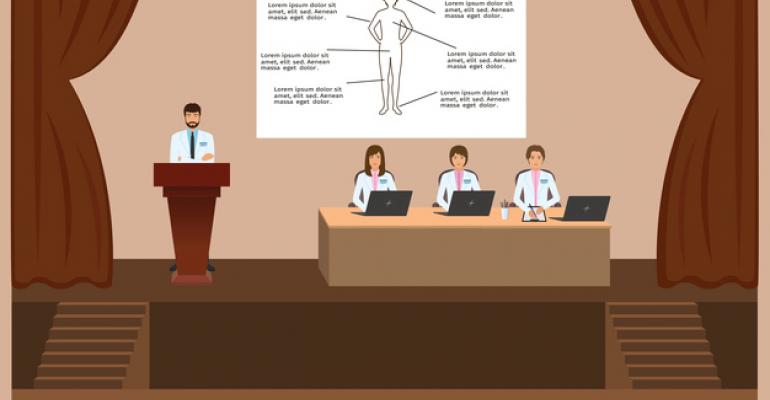Every generation brings a new set of needs and interests that industries across the board must cater to. The meetings and events industry is no exception, as meeting owners must be on top of trends from the business and consumer worlds to engage their audiences. Today’s meeting owners must infuse more digital elements and more creativity into their events, and strongly demonstrate the impact their event will have if they want to be able to pull people away from their offices.
Healthcare congresses and events are a particularly tricky sector within the M&E space because they are heavily regulated and compliance-driven—and they also are the largest segment of educational meetings. Although this has been the norm for quite some time, the changing regulatory landscape has only increased pressure for meeting planners to deliver and execute events that not only fall in line with evolving regulations, but also meet the needs of an evolving audience. For example, the introduction of stringent transfer of value (ToV) reporting requirements has pushed stakeholders from healthcare and pharma organizations to re-evaluate the way their congresses can adapt and be successful.
Leaning into these trends will help healthcare and pharma congress organizers grow attendance and effectively communicate with their target audience of healthcare professionals, or HCPs. The challenge arises when they must balance trends with regulatory and other considerations. To shed light on how healthcare and pharma organizations can strike this balance, American Express Meetings & Events developed a report called “On the Horizon: Healthcare Congress Trends to Watch,” which highlights key sector trends and how they can be integrated into congress strategy.
So Many Congresses … So Little Time
HCPs and other healthcare congress attendees are more often than not under extreme time pressures imposed by patients and practice management. This time crunch also runs parallel to the decreasing amount of funding for congress registration fees, since complimentary passes are hard to come by. In 2015 alone, physicians surveyed for the AEM&E report received invitations to an average of 16 meetings, of which they only attended 50 percent. When weighing whether or not to attend an industry event, HCPs must ask themselves, “How do the benefits of attending this meeting or event weigh against the hard and soft costs of being away from my practice?”
Further complicating this decision are safety and security, which are among the top concerns for congress-goers. The significant travel that is often required to attend these events opens up the possibility of emergency situations caused by terrorism, cybersecurity, health concerns, or other disruptions. A May 2017 study by American Express Global Business Travel and the Association of Corporate Travel Executives found that 31 percent of travel managers reported increased inquiries about data security in the previous three months, demonstrating traveler concerns that are often at play when traveling for conferences. This is just one example of the many considerations HCPs weigh when an invite comes their way.
Shaking Up the Learning Environment
Finding new ways to deliver education to healthcare providers is also another challenge healthcare congress organizers face when planning their events. Since there are so many medical-related congresses and events, it can be a challenge to develop new and innovative ways to lure attendees that won’t break the bank. Organizers need to develop engaging and hands-on experiences for attendees, so that they can enjoy interactive sessions that extend well beyond some of the more traditional formats. In addition, because the number of congress attendees continues to decrease, companies are focusing more on the quality of an event, rather than the quantity of attendees. They also are leveraging different formats for learning environments, such as live-streaming, to bring in a younger audience.
The 2017 American Academy of Orthopaedic Surgeons annual conference was one example of a healthcare organization using unconventional programming to shake up the learning environment. The conference website promoted Bioskills sessions that allowed off-site exhibitors to virtually demo their procedures. It also hosted several ask-the-expert sessions to engage with the audience more, providing attendees with the opportunity to present cases for diagnosis and recommendations. The conference wove in a good mix of technology implementation as well as an interactive experience for an evolving audience. These are all worth replicating, but it’s also important to think creatively about audience needs to yield fresh ways to rethink event programming and content delivery.
Embrace the Future
As the new generation of healthcare providers demands more digitally integrated events, organizers must deliver on these experiences to stay relevant. Planners should consider supplementing congresses with digital, on-demand learning options that extend the congress experience long after the event and are likely to resonate with a younger attendee. Of the professionals surveyed for the American Express Meetings & Events study, 80 percent believed that the next generation of healthcare providers, who are tech savvy and raised on social media, will be the drivers of substantial change in new attendee engagement strategies. To engage them early, planners should consider digital add-ons like online tools that allow attendees to create their own learning path at the event, or event apps with functions that go beyond attendee expectations, with features such as networking channels.
Healthcare congresses have a lot of work ahead of them to sustain and increase attendance, while creating value and measurable return. In the face of these challenges and those imposed on them by regulatory bodies, they must also shake up the ways they engage with their audience to proactively seek the next generation of HCPs who value creativity. The stakes are high, but with their practiced adaptability and ingenuity, healthcare congress planners can keep HCPs coming back.
Lisa McKenzie is vice president, pharmaceutical and healthcare, with American Express Meetings & Events.





